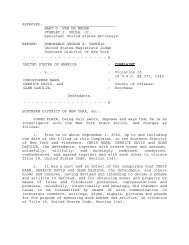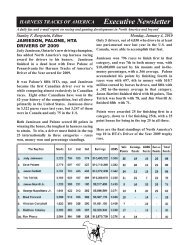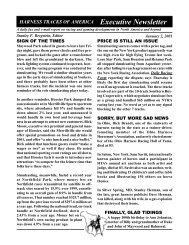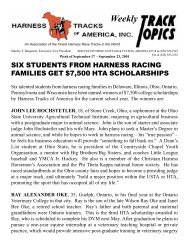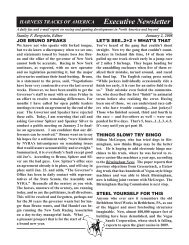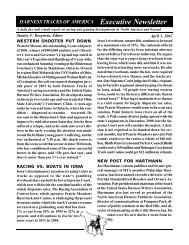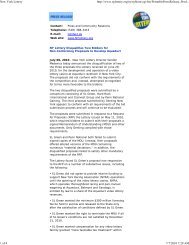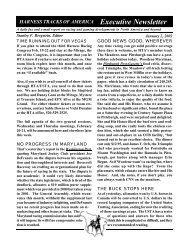2005 - Harness Tracks of America, Inc.
2005 - Harness Tracks of America, Inc.
2005 - Harness Tracks of America, Inc.
You also want an ePaper? Increase the reach of your titles
YUMPU automatically turns print PDFs into web optimized ePapers that Google loves.
HARNESS TRACKS OF AMERICAExecutive NewsletterA daily fax and e-mail report on racing and gaming developments in North <strong>America</strong> and beyondStanley F. Bergstein, EditorA VICTORY FOR RACING IN KYIn a victory for horse racing everywhere and particularlyin Kentucky, the Kentucky Horse RacingAuthority yesterday unanimously approvednew drug rules for the state, over the objections<strong>of</strong> horsemen. It also was a triumph for commonsense. The Lexington Herald-Leader, in itsKentucky.com online news, got it right. The serviceheadlined a story by business writer JanetPatton “Fewer drugs will be at the post.” Thenew regulations give Kentucky rules that closelyfollow those adopted by the national RacingMedication and Testing Consortium, and ConnieWhitfield, vice chair <strong>of</strong> the Racing Authority andchair <strong>of</strong> the Kentucky Equine Drug ResearchCouncil, was on target in her assessment <strong>of</strong> thesignificance <strong>of</strong> the Authority’s action. “Thesechanges,” she said, “not only advance the integrity<strong>of</strong> racing in Kentucky, but also protectthe health <strong>of</strong> the horse and the safety <strong>of</strong> therider.” Racing Authority chairman Bill Streetnoted that “these amendments will create themost comprehensive drug rule in the country andwill help protect the integrity <strong>of</strong> horse racing inKentucky.” Street said he would ask Gov. ErnieFletcher, who appointed the new Authority, tosign emergency regulations that would put therules and penalties into immediate effect. Streetsaid <strong>of</strong> the Authority action, “I think it’s the rightthing to do for horse racing in this state. Thenext challenge for us will be to make sure therule is administered as intended. That meansenforcement.” If Authority executive directorJim Gallagher has his way, there will be no questionabout that. He said, “The former KentuckyRacing Commission adopted internal policies in1998 and again in 2002 which made Kentuckythe most liberal and permissive state in the countryfor equine medications. Those policies neverwent through the proper administrativereview process, were not subject to publicreview or comment, and were never re-August 16, <strong>2005</strong>viewed by the appropriate legislative committees.But they were applied as if they had been.”Gallagher, a disciplinarian with long experiencein New York, is the man to make sure Street’smandate is carried out. Toward that goal, hewill work with retired jockey Patti Cooksey, thenew deputy executive director <strong>of</strong> the Authority,on enforcement issues. The new rules limit use<strong>of</strong> non-steroidal anti-inflammatory drugs to one<strong>of</strong> three allowed, and then not later than 24 hoursbefore a race. Only Salix and either phenylbutazone,banamine or ketopr<strong>of</strong>en will be allowedunder the new rules. Kentucky had allowed themto be used as cocktails up to 4 hours before posttime. To no one’s surprise, Marty Maline, theexecutive director <strong>of</strong> the Kentucky HBPA, objectsto the rule changes. Our congratulationsto the Kentucky Authority for its firm and progressiveaction in turning Kentucky from a racingjoke on its former permissiveness into a respectedleader in medication reform.A VEXING PROBLEM REMAINSWhile Kentucky moved ahead on the medicationissue, it still struggles with the problem <strong>of</strong> insurancefor participants against catastrophic injuryor disability, and how it will be handled. An 11-member committee appointed by the governor deliberatedfor two and one-half hours yesterday,but came to no definitive agreement on the form<strong>of</strong> coverage, who should be included, and how topay for it. One two-tier plan suggested wouldmake jockeys employees <strong>of</strong> trainers rather thanindependent contractors, with workers’ compensationcoverage, and with trainers obtaining workers’comp coverage <strong>of</strong> their own for exercise riders.The governor asked the panel to finalize itsproposals by September 1, and it adjourned yesterdaywith another meeting scheduled for thatdate to resolve differences, if possible, betweenjocks, legislators, horsemen’s organizationsand tracks.




